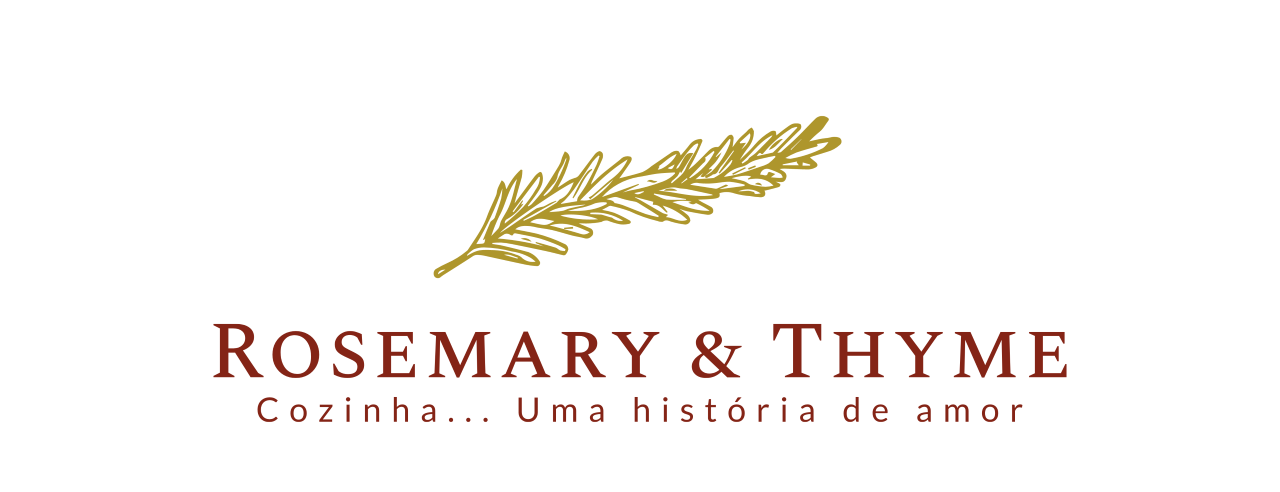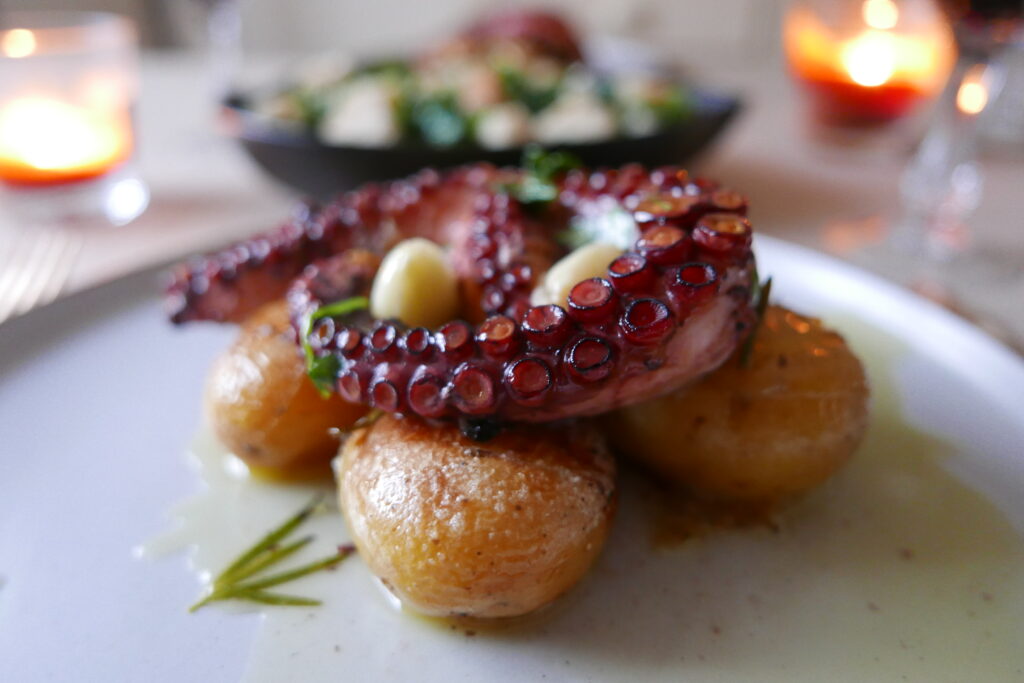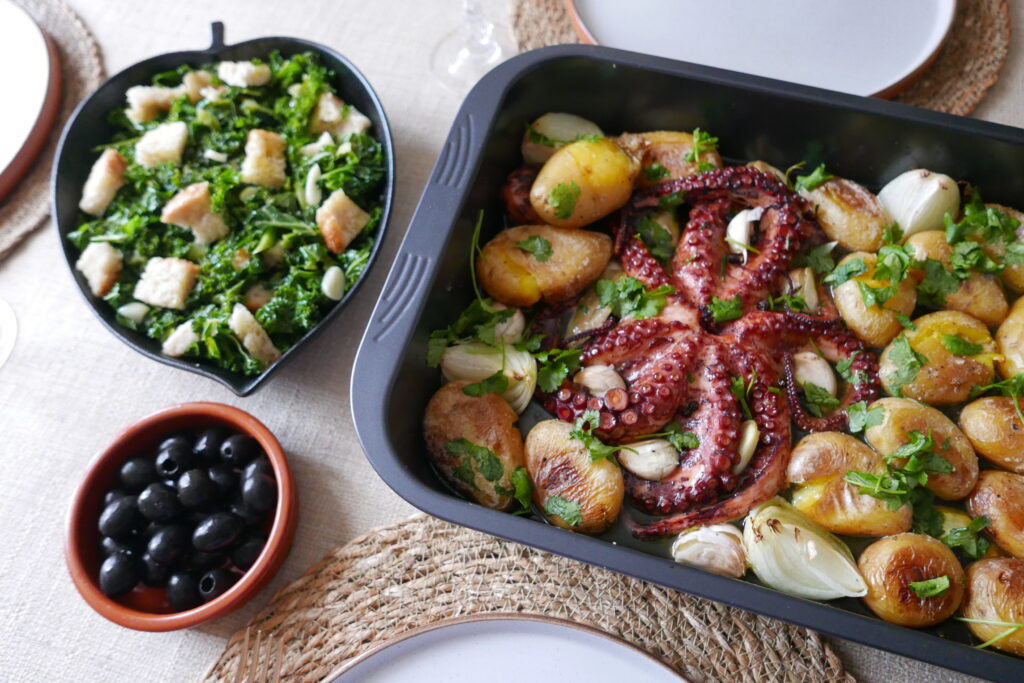
For the first dish published here, I chose a classic of Portuguese cuisine, the famous Polvo (Octopus) à Lagareiro, which I highly recommend to all octopus lovers. The expression “Lagareiro” means “miller”, someone who worked in a mill in the production of olive oil. It gives it’s name to this recipe due to the abundant amount of olive oil that is used to prepare this recipe. Although not consensual, it is believed that this recipe originated in the Trás-os-Montes region, not surprising, taking into account the good olive oil from Trás-os-Montes and its tradition in the treatment of the olive tree. This is undoubtedly a popular recipe on the menu of the best and finest restaurants in Portugal.
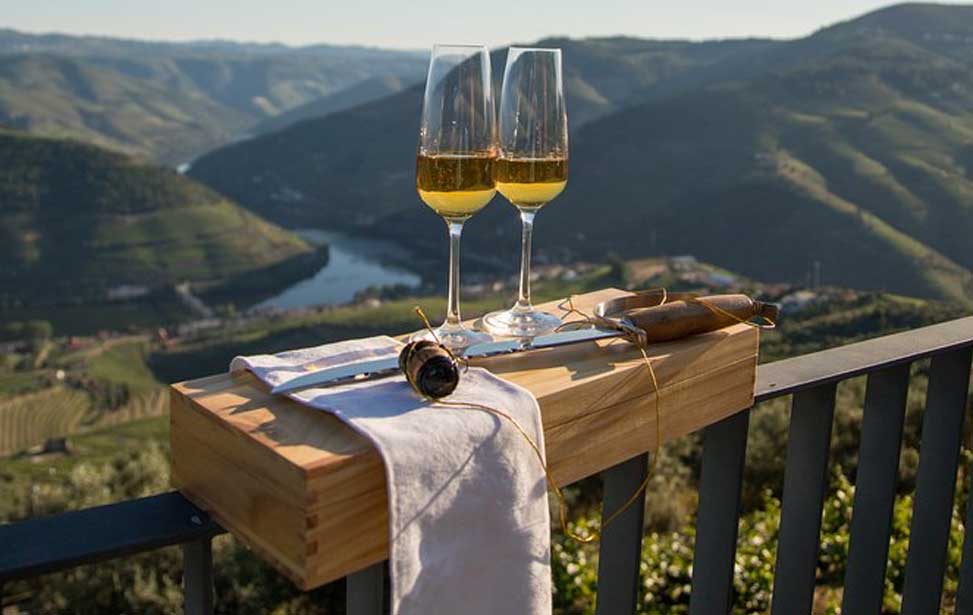
Beautiful region of Trás-os-Montes, where it’s believed that this recipe originated.
Not being a difficult recipe to prepare, many questions arise on how to prepare it. It’s important to follow certain procedures to ensure that the octopus meat doesn’t end up under-cooked and hard but achieves the right texture. I have already tried several differently cooked versions of Polvo à Lagareiro, but the version I present here is my favourite. It leaves the octopus tender, intact, aromatic, with the garlic just right and the potatoes crunchy and tasty.
TIPS
- It is always important to first preheat the oven.
- There is no need to season the polvo with salt. It will already contain enough salt itself.
- I recommend buying frozen octopus. When frozen, the octopus meat tends to soften which will result in making it more tender and easier to cook. If using fresh octopus, you can choose to freeze it for 24 hours. Allow the octopus to thaw first before cooking.
- Select an medium octopus with a pinkish colour and a weight approximately between 1.2kg to 1.5kg. Octopus tend to reduce in volume by half during cooking, but as with meat, it’s the youngest octopuses that have the best taste and require less cooking time to be tender. The larger and older octopuses should be avoided. It’s preferable to buy 2 smaller octopuses than one very large octopus.
- Before placing the octopus in the oven, boil it in a shallow water first and with the tentacles facing upwards (so as not to cover the octopus with water), and over medium to low heat for around 45 to 50 minutes, avoiding removing the lid from the pan. This cooking process ensures that the octopus retains its suckers intact and remains tender. If you choose to cook it in a pressure cooker, the cooking time will be reduced but tends to render the octopus less presentable. Cooking time may be longer if you choose a larger octopus.
INGREDIENTS (serves 2-4)
To boil the octopus:
1 octopus (1.2 kg to 1.5 kg)
1 onion
3 cloves (optional)
1 crushed and unpeeled garlic clove
2 bay leaves
250ml to 300 ml of water
For the remainder:
Approx.12/16 new (baby) potatoes
2 tablespoons coarse salt ( for the potatoes)
250 ml of virgin olive oil
1 unpeeled garlic head
1 bay leaf
black pepper in grain
Small sprig of rosemary
Small sprig of thyme
2 shallotes or 1 onion (optional)
Coriander
For the vegetable accompaniment:
Kale or turnip greens (250gr/300gr)
1 tomato cut into small cubes without skin or seeds
1 small chopped onion
1 or 2 minced garlic
2 slices of crushed bread (like grated bread) or if you prefer, slightly toasted and cut into small cubes.
Kale or turnip greens (250gr/300gr)
Pinch of salt
PREPARATION
First Boil the Octupus
Start by placing 1 peeled onion in a pot with 3 cloves embedded in it (cloves are optional), 1 crushed unpeeled garlic, a bay leaf, and the octopus (previously washed / eyes removed, head separated from the tentacles) with the tentacles facing upwards. Place the octopus in about 250ml to 300ml of water, without covering the octopus, as it drains water whilst cooking.
Cover and simmer over a medium heat for 45 to 50 minutes, until the octopus is cooked and tender. During the cooking process, avoid removing the lid, but carefully shake the pot every 15 minutes.
While the octopus is cooking, wash the potatoes and place them whole, skin on and dry on a tray, cover them with plenty of coarse salt and bake at 200º C conventional oven ( 180º C fan, 400°F, Gas mark 6) for about 40m, until they are soft (no oil, just salt).
After roasting, wipe off excess salt (without washing) and slightly crush each one with the side of a flat cooking utensil to open them up.
Roast The Octopus
After the octopus is cooked, drain and separate the head and keep the tentacles whole. Place all of the octopus parts on a roasting tray along with the previously roasted potatoes.
Crush the several garlic cloves with the skin on, place them in a pan with the olive oil (the skin intensifies the flavour and helps prevent them from burning), a bay leaf and a few black peppercorns. Bring to a boil (boil for 1 minute). Pour everything over the potatoes and the octopus.
Spread the thyme and rosemary sprig (slightly wet) across the octopus and potatoes. You can also add 1 or 2 shalottes.
Place the tray in the preheated oven for approximately 15 to 20 minutes at 200 °C Conventional oven until the octopus is toasted.
After roasting, serve the octopus immediately using the roasted potatoes as a base, with sliced or the whole garlic cloves, and a sprinkling of chopped coriander along with a drizzle with hot olive oil from the tray.
Accompaniment of sautéed vegetables and bread
This dish is traditionally served with julienned kale or turnip greens. In both cases the vegetables should be slightly boiled with a pinch of salt, rinsed in very cold water after being cooked and finally sautéed (sautéed with crushed bread or cut into small cubes). Personally, I prefer to sauté vegetables with crushed bread.
To sauté the vegetables and the bread, first sauté 1 chopped onion, 2 cloves of garlic and a tomato cut into small cubes without skin or seeds with a good drizzle of olive oil. Then add the previously cooked vegetables and the bread, verify the salt and sauté everything for 1 or 2 minutes.
This dish marries well with a good fresh white wine
As Polvo à Lagareiro is a dish with potatoes, lots of garlic and a large amount of olive oil, it harmonizes well with fresh, mineral and structured white wines. Douro and Dão whites with some time spent in wooden barrels go very well. If you like more acidity, the traditional Bucelas wines with the Arinto grape variety are another good option. If you are more inclined towards red wines, then a good structured rosé will also go down well, as long as they are not too light. The tannins in red wines may not blend as well, and by choosing red wines with low tannins, the red wine will lack character.
Enjoy!
VERSÃO PORTUGUESA
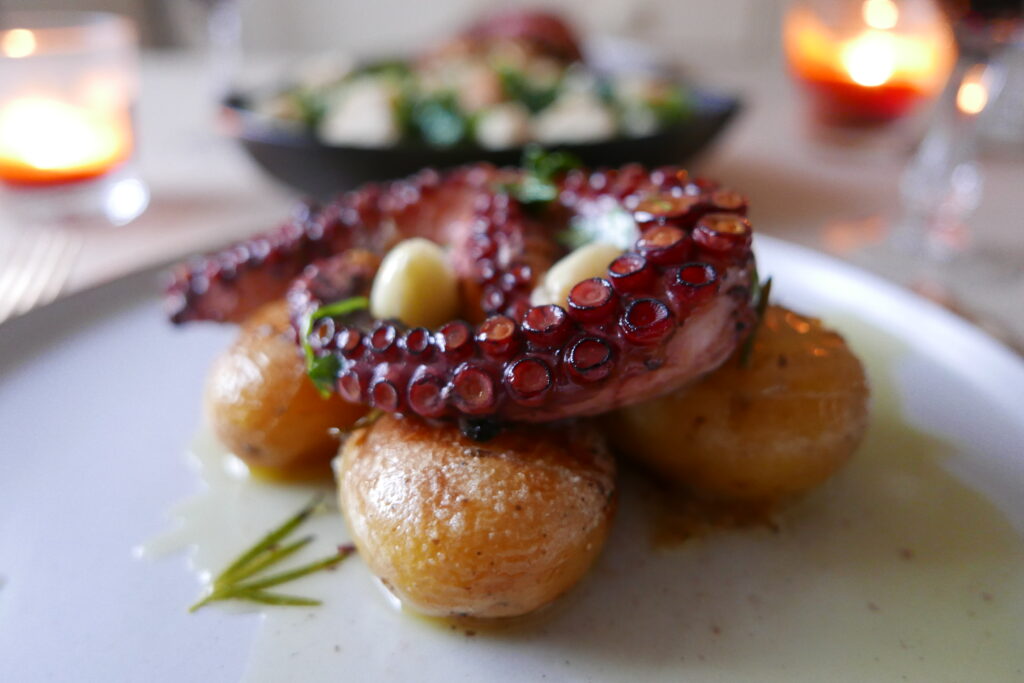
Para o primeiro prato aqui publicado, escolhi um clássico da gastronomia Portuguesa, o famoso Polvo à lagareiro que vivamente recomendo a todos os apreciadores de polvo. A expressão “lagareiro” refere-se a um indivíduo que trabalha num lagar, na produção de azeite. Dá nome a esta receita devido à quantidade abundante de azeite que é usada para preparar-la. Não é consensual, mas acredita-se que esta receita teve a sua origem na região de Trás-os-Montes, o que não é de admirar tendo em conta o azeite de boa qualidade produzido nessa região e a sua tradição no tratamento das oliveiras. Esta é hoje e sem dúvida, uma receita popular na ementa dos melhores e mais finos restaurantes de todo o Portugal.
Não sendo uma receita difícil de preparar, surgem muitas dúvidas de como prepara-la. É importante seguir alguns procedimentos para garantir que o polvo não fica duro, desfeito e que atinge a cozedura e textura certa. Já experimentei várias versões de Polvo à Lagareiro, mas a versão que aqui apresento é a que mais gosto. Deixa o polvo tenro, intacto, aromático, com os alhos no ponto certo e as batatas crocantes e saborosas.
DICAS
- É sempre importante ter o forno pré-aquecido antes de colocar o polvo
- Não necessita colocar sal no polvo. O polvo já contém em si o sal suficiente.
- Será preferível optar por comprar um polvo congelado. Quando o polvo é congelado sofre um choque térmico que tende a amaciar as fibras do polvo, o que contribui para que ele fique mais tenro e fácil de cozinhar. Se usar polvo fresco, pode optar por congela-lo por 24 horas. Para cozinhar terá apenas de deixá-lo descongelar novamente.
- Prefira polvos de tamanho médio, de cor rosada e com aprox. 1,2kg a 1.5kg. O polvo reduz o seu volume para metade após a cozedura, mas tal como a carne, são os polvos mais novos os mais saborosos e os que requerem menor tempo de cozedura para ficarem tenros. É preferível comprar 2 polvos mais pequenos do que um muito pesado.
- Antes de levar o polvo ao forno, opte por coze-lo em pouca água (de modo a não cobrir o polvo), com os tentáculos virados para cima e em lume médio a fraco durante 45m a 50m. Evite retirar a tampa do tacho durante a cozedura, apenas abane o tacho de 15 em 15 minutos. Este processo de cozedura garante que o polvo permanece com as ventosas intactas e fica tenro. Se optar por coze-lo na panela de pressão cozerá mais rápido, mas tenderá a não ficar tão bonito.
INGREDIENTES ( 2-4 pessoas)
Para cozer o polvo:
1 polvo (1,2 kg a 1.5 kg)
1 cebola
3 cravinhos (opcional)
1 alho esmagado, com casca
2 folhas de louro
250 a 300 ml de água
Para o restante:
Aprox.12/16 batatas pequenas para assar
1 mão cheia de sal grosso
250 ml de azeite
1 cabeça de alhos com casca
1 folha de louro
Pimenta preta em grão
Pequeno ramo de alecrim
Pequeno ramo de tomilho
2 chalotas ou 1 cebola
Coentros
Para o acompanhamento de legumes:
Couve galega ou grelos (250gr/300gr)
1 tomate cortado em cubos, sem pele nem sementes
1 cebola pequena picada
1 ou 2 alhos laminados
2 fatias de pão triturado (tipo pão ralado) ou se preferir, ligeiramente torrado e cortado em pequenos cubos.
1 pitada de sal
PREPARAÇÃO
Cozer o Polvo Primeiramente
Comece por colocar num tacho 1 cebola descacada com 3 cravinhos nela cravados (cravinho é opcional), 1 alho com casca esmagado, 2 folhas de louro, e o polvo com os tentáculos virados para cima (previamente lavado, olhos retirados, cabeça separada dos tentáculos). Coloque cerca de 250ml a 300ml de água, sem que a água cubra o polvo.
Tape e cozinhe em lume médio (evitando uma ebulição forte) durante 45 a 50 minutos, até que o polvo esteja cozido e tenro. Durante o processo de cozedura evite retirar a tampa, mas abane cuidadosamente o tacho de 15 em 15m.
Enquanto o polvo coze, lave as batatas, coloque-as inteiras com pele e secas num tabuleiro, cubra-as com bastante sal grosso e leve ao forno a 200º C ( 180º C fan, 400°F, Gas mark 6) cerca de 40m, até estarem macias.
Levar o Polvo a Assar
Depois de assadas, limpe o excesso do sal (sem lavar) e dê-lhes um murro para as abrir um pouco. Disponha-as num tabuleiro onde colocará também o polvo depois de cozido.
Depois de o polvo estar cozido, escorra e separe a cabeça e mantenha os tentáculos inteiros. Coloque-o no tabuleiro junto com as batatas previamente assadas.
Esmague os dentes de alho com a pele, coloque-os num tacho com o azeite (a pele intensifica o sabor e contribui para que não se queimem), uma folha de louro e uns poucos grãos de pimenta preta. Leve ao lume e deixe ferver durante 1 minuto. Verta tudo sobre as batatas e o polvo.
Espalhe o ramo de tomilho e alecrim (previamente molhados) pelo tabuleiro. Pode ainda acrescentar 1 ou 2 chalotas ou 1 cebola cortada em quartos.
Leve tudo ao forno durante 15 a 20 minutos a 200 °C até o polvo tostar. O forno deverá estar previamente aquecido.
Sirva o polvo de imediato com as batatas na base, com os alhos laminados ou inteiros, polvilhado com coentros picados e tudo regado com azeite.
Acompanhamento de pão e legumes salteados
Este prato é tradicionalmente acompanhado com couve galega cortada em juliana ou grelos. Em ambos os casos os legumes devem ser ligeiramente cozidos, passados por água bem fria após cozidos e por fim salteados (salteados com pão triturado ou torrado e cortado em pequenos cubos). Pessoalmente, eu prefiro saltear os legumes com o pão triturado.
Para saltear os legumes e o pão, refogar primeiramente num bom fio de azeite 1 cebola pequena bem picadinha, 2 dentes de alho picados e um tomate cortado em pequenos cubos, sem pele nem sementes. Adicionar posteriormente os legumes previamente cozidos e o pão, verificar o sal, e saltear tudo durante 1 ou 2 minutos.
Este prato casa bem com um vinho branco fresco
Como o Polvo a Lagareiro é um prato com batatas, muito alho e com uma grande quantidade de azeite, harmoniza bem com vinhos brancos frescos, minerais e estruturados. Os brancos do Douro e Dão com alguma passagem por barricas de madeira vão muito bem. Se gosta de mais acidez, os vinhos tradicionais Bucelas com a casta Arinto são outra boa opcão. Se preferir algo mais para o tinto, um bom rosé estruturado pode cair bem, desde que não sejam muito leves. Os taninos dos vinhos tintos podem não casar tão bem, e se escolher vinhos tintos com baixos taninos, faltará personalidado ao vinho tinto.
Bom apetite!
